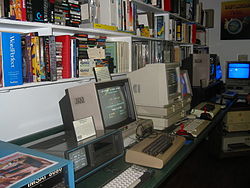 Some personal computers on an interactive display | |
 | |
| Established | 2005 |
|---|---|
| Dissolved | 2018 |
| Location | Brantford, Ontario, Canada |
| Coordinates | 43°09′26″N80°15′54″W / 43.15720°N 80.26501°W |
| Type | Personal Computer museum |
| Curator | Syd Bolton |
| Website | http://www.pcmuseum.ca/ |
The Personal Computer Museum was located in Brantford, Ontario, Canada, in a building formerly owned by the municipal government. The building was built with bricks reclaimed from the Brantford Opera House.
Contents
Over fifty interactive personal computers were on display, from a wide variety of manufacturers, including Apple, Atari, Commodore, IBM, Radio Shack, Timex, Mattel, and others. The museum also had a large library of original software and a huge archive of computer-related magazines.
The museum's mandate was to preserve computer technology and, more importantly, to offer interactivity with older machines. It welcomed private tours from schools and other groups. It was open to students, to study the origins of computers and the various technologies involved. Parents were welcome to bring children, to see computers which the parents may have once used, to get a sense of the ancestry of today's technology. Admission was free.
The museum first opened to the public in September, 2005. [1] It was run by Syd Bolton, its founder and curator, and by a group of dedicated volunteers.
In 2018, the museum closed permanently following Bolton's death. At that time, it had been open to the public only one day a month. Its contents were transferred to University of Toronto Mississauga library in October 2020. [2]
